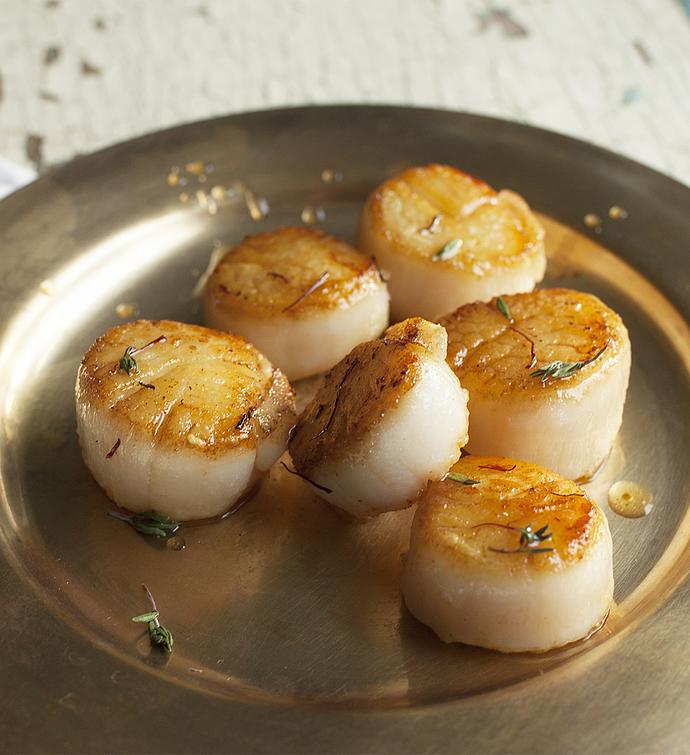Scallops 5 Ways
Each dish is a scrumptious reminder why this shellfish is one of the most versatile proteins from the sea.
Aug 27, 2025
I have always loved scallops. As a kid, I usually had them as part of a “Captain’s Platter,” a large plate of fried seafood and French fries.
Once I began cooking professionally, I was able to work with more types of scallops and cooking techniques. I still remember the first time I cracked open a live scallop shell and was overtaken by the briny aroma. As I removed the scallop from the shell, I noticed the firm texture of the flesh and the plump roe that was attached to the scallop.
I learned about the many techniques that can be applied to this sweet and slightly briny shellfish, and I still appreciate its unique flavor. Scallops’ quick cooking time and ability to absorb flavors make them a fun and versatile protein to work with.
READ MORE: The Art of Searing Scallops
Not only are there so many ways to make scallops but there are several types of scallops, too. I’m going to teach you how to make five different scallop dishes using three different types of wild scallops: wild Atlantic scallops, wild Patagonian scallops, and wild Alaska scallops.

Wild Atlantic Scallops
These are sweet, plump sea scallops that come 25 to 30 per pound, so they cook quickly. They have a firm and buttery texture when cooked, and come frozen.
Seared Scallops With Citrus and Walnuts
Make sure your scallops are patted dry and seasoned with salt and pepper. Preheat a cast-iron or carbon steel pan and add some neutral oil or clarified butter until it shimmers. Gently add the scallops, allowing for some space between each one, and let them sear for two to three minutes on medium-high heat. Once they have some color on the edges, add 1 to 2 tablespoons of butter and spoon the butter as it browns over the scallops. Once they are well browned, flip them over and remove the pan from the heat. After one minute, remove the scallops to a plate and return the pan to the heat. Add some broken walnut pieces and let them toast in the brown butter for one to two minutes, then add some citrus segments, a spoonful of capers, and some roughly chopped parsley. Spoon the mixture over the scallops and serve.
Marinated Scallops With Horseradish and Beets
Take the scallops and, with a very sharp knife, slice them into three or four slices, depending on their thickness. Place the slices in a single layer on a tray or large plate. Drizzle with extra-virgin olive oil, freshly grated horseradish, orange zest, sea salt flakes, and ground white pepper. Cover with plastic and allow to marinate for 15 to 20 minutes.
In a separate bowl, add some diced and cooked beets and finely diced celery. Dress with olive oil, white balsamic vinegar, a squeeze of lemon, and salt and pepper. Toss and set aside.
Place four to five slices of scallop on each serving plate in a pinwheel design and spoon some of the beet mix in the middle of the pinwheel. Drizzle any excess dressing around the edge of the plate and garnish with baby arugula greens.
Wild Patagonian Scallops
These are like bay scallops, 80 to 100 pieces per pound, and are quick frozen, without any additives. These scallops are great for ceviche or tossed into pasta or risotto.
Scallop Ceviche With Aguachile and Avocado
Make an aguachile by combining fresh green chiles, cilantro, lime juice, and coconut water in a blender and blending until smooth. In a large mixing bowl, place 1 pound of the scallops, season with salt and lime juice, and marinate for 10 to 15 minutes. In medium glass bowls, place a spoonful of the scallops and top with a few ounces of the aguachile, some diced avocado, cilantro sprigs, chunks of cucumber, and pickled onions.
Tempura Fried Scallops With Preserved Lemon Tartar Sauce
This is a lighter version of the fried scallops I grew up eating on summer vacations. For this version, you will want to salt the scallops before coating and let them drain any excess liquid.
Make a thin batter with cornstarch, flour, salt, and water, and strain it into an iSi whipping siphon. Charge with an N2O cartridge and shake well. Lightly coat the scallops with cornstarch, shake off any excess, and then place them on a small dish or sheet tray. Dispense the batter over the scallops and drop it into a 375-degree Fahrenheit fryer. Fry for two to three minutes, until golden and crispy. Make a tartar sauce with mayo, diced preserved lemon, shallots, diced cornichons, and lemon juice.
Wild Alaskan Scallops
These Alaskan scallops are hand harvested and have tender white flesh. They come about 25 to 30 a pound.
Grilled Scallops Over Roasted Corn Polenta
I love the smoky char you get when grilling scallops over charcoal or wood.
Prepare a grill with charcoal or hardwood and allow it to get to embers before you start cooking. Before you cook the scallops, grill a few ears of corn and then remove the kernels from the cobs. Make polenta and mix in the grilled corn along with mascarpone, chives, and basil.
Season the scallops with salt and pepper, and spray with olive oil before grilling. Place the scallops on the hottest part of the grill and allow them to cook until the sides show some color. Then, turn them one time and cook for another couple of minutes; you are looking for a nice char on the outside without overcooking the scallops. Serve over the polenta.









